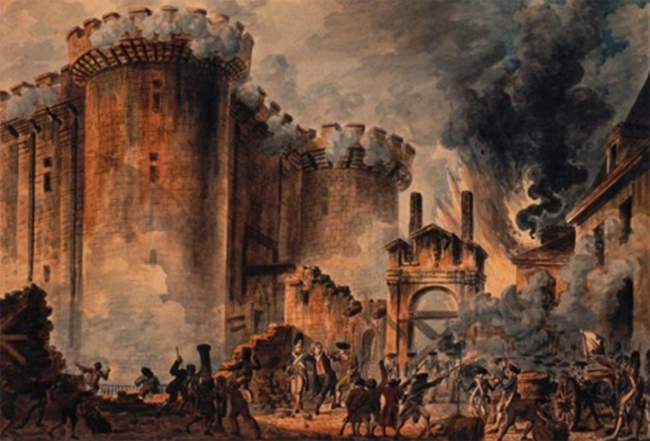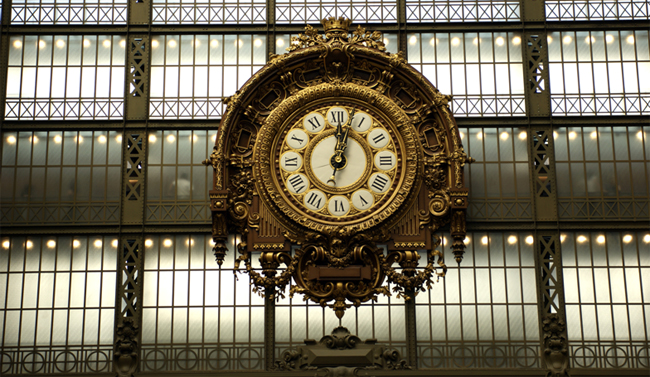Top 9 fun facts about the French Revolution
*Written by Matthieu in November 2017 and edited/updated by Arielle in November 2019
The French Revolution was a period of time in France when the people overthrew the monarchy and took control of the government. Lasting 10 years from 1789 to 1799, it began on July 14, when revolutionaries stormed a prison called the Bastille- which is now the celebrated Bastille day (basically the French version of America’s July 4th!)
There were many reasons this war broke out. The bourgeoisie—merchants, manufacturers, professionals—had gained financial power but had no political power. Those who were socially beneath them had very few rights, and most were also extremely impoverished. When the king aimed to increase the tax burden on the poor and expand it to classes that had previously been exempt, that is when the revolution became inevitable.
There are actually so many other factors that went into one of the most prominent eras in history, but I won’t bore you with the boring facts.
If you’re curious and want to know more about French history and events that influenced one of the most important periods in history, you might also want some fun facts to go with it! Read on to find out our top 9 fun facts about the French Revolution.
We were introduced to the Guillotine, which beheaded over 18,000 people!

The revolution and the reign of terror that ensued, led by Maximilien Robespierre, one of the best-known and most influential figures of the French Revolution, have caused thousands of casualties: over 18,000 people were beheaded in all, although some historians estimate the deaths to go as far as 40,000. But it’s a case of the biter bit because Robespierre himself was executed by the guillotine (more information about the guillotine here), on July, 28th of 1794.
Same goes for our dear Louis XVI. He experienced first-hand an “improvement” of the guillotine that he had contributed to. Indeed, word is that he was the one to suggest that a triangular blade might make the guillotine more efficient.
But you may have thought that the horror of the guillotine ended with the Revolution: well, it didn’t. Prisoners sentenced to death could still be executed by way of guillotine until death sentence was abolished in 1981, although the last execution happened in 1977.
Louis XVI and his family failed to escape because his face was recognized on the coins

Here is a little-known fact. When things really heated up in France, Louis XVI, Marie-Antoinette and the family, afraid for their safety, tried to escape the country.
But they were caught right at the border. For people who didn’t live in Versailles, it was difficult to know what the royal family looked like. There were no pictures, no paintings available to the working classes. But there was still one direct “contact” between the French and the King: the coins!
It seems strange that this carefully planned escape failed because of coins, but it is true! A fun fact about the French revolution is that Louis XVI got recognized because of those small pieces of gold. Then, they were brought back to Paris and sentenced to death… But did you know that Louis XVI almost escaped the death sentence?
King Louis XVI’s own cousin voted in favor of his death sentence!

Indeed, the fate of the King was voted in the Parliament. Three hundred and sixty-one voted in favor of the execution, two hundred and eighty-eight voted against it. But as it was later found out, many of the members of Parliament didn’t dare to go against the majority.
And a fun fact about the French revolution is that Louis XVI’s own cousin voted in favor of the execution! The King was executed at Place de la Concorde, that used to be called Place de la Révolution (Revolution Square, in English). Called Louis Philippe d’Orléans but most commonly known as Philippe Egalité, that man was more liberal than the rest of his family. Still, he ended up being beheaded as well. However, his unexpected gesture counted in the eyes of the revolutionaries, because after the revolution of 1830, it was Philippe Egalité’s son who was crowned king, as a sign of the renewal of the monarchy.
The Bastille was torn down by hand because they didn’t have explosives!

The event that is commonly known as marking the beginning of the French Revolution is the storming of the Bastille prison. But a fun fact linked to this is that there were actually only seven prisoners in the prison that day! One of them being the infamous Marquis de Sade, who gave his name to sadism.
And another fun fact about the French Revolution and Bastille is that the building was torn down by hand by the revolutionaries since most of them were peasants who didn’t have access to explosives or more destructive weapons. In fact, the attackers were way more interested in the stock of arms and powder kept within the walls of the prison than in the prisoners.
Marie Antoinette had some very strange last words…

Marie-Antoinette was despised during her life, but she is more loved today and more famous than any other French queen. This is why some historians have tried to rehabilitate her reputation: for instance, she was believed to have said, when the Parisians came to Versailles to ask for bread: “If they can’t have bread, let them have cake“. But, very likely, she never said that, and the rumors of the time distorted who she truly was.
In fact, the last words she is supposed to have said are “I’m sorry“, for stepping on the executioner’s toe… How sad! And another fun fact about the French Revolution and about the most famous Queen of France is that Marie-Antoinette supposedly gave the executioner a purse full of gold coins, to make sure that the blade was sharp and that her death was going to be clean and quick. Like the King, she was executed at Place de la Concorde.
>> Read more about French Queens on Discover Walks
They used a different calendar to make telling time easier

Everybody knows that there are 24 hours in a day, 60 minutes in an hour, and 60 seconds in minute. But in between 1793 and 1805, the French rid of the old clock system in favor of French Revolutionary Time, which was a 10-hour day, with 100 minutes per hour, and 100 seconds per minute.
There were still 12 months but they were divided into three ten-day weeks, each ending in a day of rest and another day equal to Sunday. Interestingly enough, It was almost identical to the calendar used by the Ancient Egyptians.
Though it was done to make counting time easier, it was widely unpopular not to mention difficult to change the clocks all over the country. The French officially stopped using decimal time after just 17 months and French Revolutionary Time was made non-mandatory starting on April 7, 1795.
The first public zoo was created in Paris during the French Revolution: the Ménagerie du Jardin des Plantes

The National Assembly passed a decision that exotic animals held privately were to be donated to the menagerie at Versailles, or killed, stuffed, and donated to scientists at the Jardin des Plantes.
They decided to keep the animals alive (yay!) and the world’s first public zoo was created in the interest of public education. At least it didn’t end badly for the animals!
Bread was a delicacy

In the late 18th and early 19th century French citizens ate about an average two pounds of bread each day. When the price of flour skyrocketed because of Louis XVI’s poor financial decisions, a loaf cost as much as a peasant’s mostly wage!
People made political pornography sketches about the monarchy…

Did you also know that during the revolution, satiric pamphlets were distributed around to citizens. These were explicit, mocking, erotic sketches which slandered the monarchy, especially against Marie Antoinette! I’ve not included one of the images above, but feel free to google “French Revolution Libelles” and see for yourself! It’s actually quite graphic.
I hope you’ve enjoyed reading our top 9 interesting facts about the French Revolution. Beyond these fun facts about the Revolution, that one may find gory, keep in mind that everything that happened during that period had a durable impact on the French mentality. Don’t blame the French, blame the Revolution! And if you are interested in more facts about the French Revolution, go to the Palace of Versailles to relive those troubled times.

 English
English








